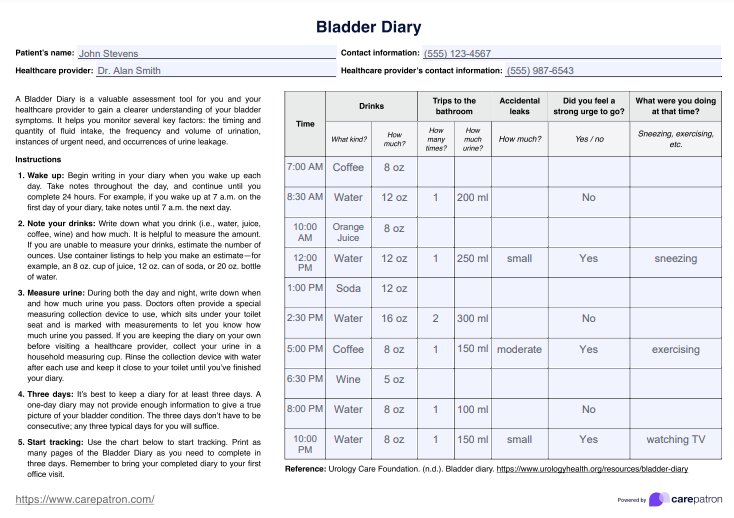Bladder Diary Template
Use our Bladder Diary Template to track and manage bladder symptoms. Enhance patient assessment and streamline treatment planning with our comprehensive guide.


What is a bladder diary?
A bladder diary is a practical assessment tool healthcare professionals use to help patients track and understand their symptoms. It involves documenting several key factors over a specific period, typically three days. These factors include the timing and volume of fluid intake, the frequency and amount of urine output, episodes of urgency, and any incidents of urinary incontinence. Having the bladder diary completed is crucial for accurate data collection and analysis.
The primary purpose of a bladder diary is to provide a detailed and accurate picture of a patient’s daily urinary habits and patterns. This information is invaluable for diagnosing conditions such as overactive bladder, urinary incontinence, and other bladder disorders. By analyzing the data in the bladder diary, healthcare providers can identify patterns, potential triggers, and underlying causes of bladder issues.
Using a bladder diary allows for a more personalized and effective treatment plan. It gives insights into the patient’s lifestyle and bladder function. It also helps monitor the progress of treatment interventions and make necessary adjustments to improve the patient’s quality of life.
Bladder Diary Template
Bladder Diary Template Example
How to use our Bladder Diary Template
Our Bladder Diary Template is designed to assist healthcare professionals in helping their patients effectively track and understand bladder symptoms. Here’s how you can guide your patients to make the most of this valuable tool:
Step 1: Download and provide the template
Start by downloading the Bladder Diary Template. Ensure you have the latest version to provide accurate and comprehensive information. Print copies or share the digital file with your patients.
Step 2: Instruct patients to begin recording upon waking
Advise your patients to start their diary as soon as they wake up. They should take notes immediately and continue tracking for an entire 24-hour period to capture a complete picture of their bladder activity over a typical day.
Step 3: Educate patients on tracking fluid intake and urine output
Explain to your patients how to record every drink they consume throughout the day, noting the type of beverage and the amount. Teach them to measure and document how much fluid they drink and how much urine they pass, including the amount of urine passed using a measuring device or household measuring cup. Measuring how much urine is passed is crucial for understanding bladder behavior and provides valuable information for healthcare professionals.
Step 4: Guide patients on noting urgency and accidents
Instruct your patients to record any instances of strong urge or when they leak urine. They should also note activities like coughing to identify potential triggers. They should describe what they were doing when the leakage occurred (e.g., sneezing, exercising) to help identify potential triggers for bladder irritation or incontinence.
Step 5: Review and follow up
Ask your patients to complete the bladder diary for three to seven days. These days don’t have to be consecutive; they can choose any three typical days that reflect their usual activities and bladder habits. Ensure they bring their completed diary to their next appointment for review and discussion.
Benefits of using this Bladder Diary Template
Using a Bladder Diary Template offers numerous advantages for healthcare professionals, providing a systematic approach to understanding and managing bladder symptoms in patients. Here are the top three benefits:
Enhanced patient assessment
The Bladder Diary Template enables healthcare professionals to gather detailed and accurate information about a patient's bladder habits. This comprehensive data helps identify patterns, diagnose conditions, and develop personalized treatment plans.
Improved patient compliance
The template provides a clear and structured format for recording patients' daily bladder activities. This simplicity encourages patients to track their symptoms consistently, leading to more reliable data for healthcare providers.
Streamlined treatment planning
With detailed records of fluid intake, urine output, and other bladder-related activities, healthcare professionals can create more effective and targeted treatment plans. The template aids in monitoring the progress of interventions and making necessary adjustments for better patient outcomes.
Commonly asked questions
Patients are typically advised to keep a bladder diary for at least three days to capture a comprehensive picture of their bladder habits. These days don’t need to be consecutive.
A bladder diary should include details about fluid intake, urine output, episodes of urgency, accidental leaks, and activities during these events to help identify triggers and patterns. It is also important to track the urge to urinate and nighttime urination to provide a complete overview of urination behaviors.
Yes, a bladder diary can help healthcare professionals monitor the effectiveness of treatment interventions and make necessary adjustments to improve patient outcomes. It helps measure how much liquid a patient is drinking, how often they have an urgent need to go to the bathroom to pass urine, and how many times they accidentally leak urine.







































































































